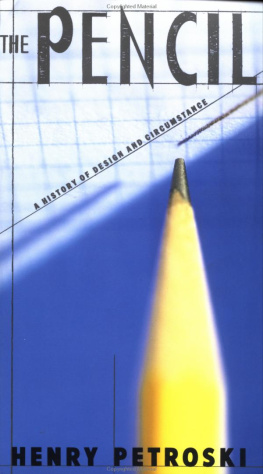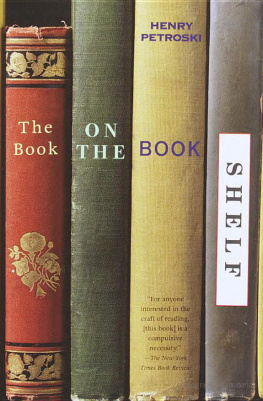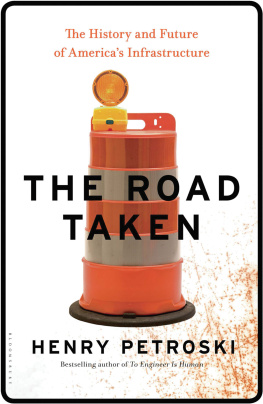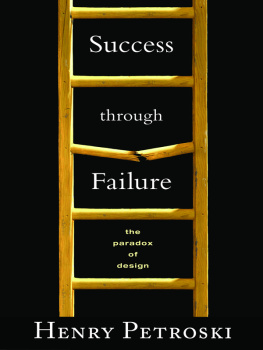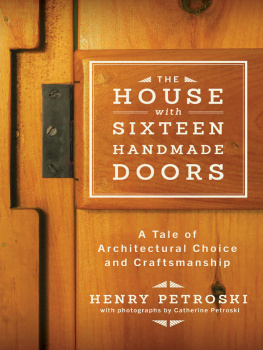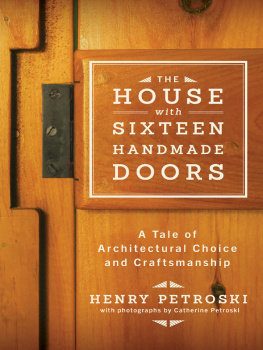Acknowledgments
Bibliographies have always seemed to me to be implicit acknowledgments, but I would like to make explicit my debt to some particular sources. While no definitive history of the pencil seems to have been written, the pioneering efforts of a few scholars gave me an initial orientation that proved to be invaluable. John Beckmanns chapter on black lead, Clarence Flemings story of the pencil, Molly Lefebures chapter on wadd, Joseph Meders chapter on graphite, and Eric Voices article on the history of the pencil are among the contents of my bibliography that I would single out.
At one point my intention was to make separate bibliographies of items pertaining to the pencil and of those pertaining to engineering generally, but I decided against that dichotomy for several reasons. While various entries might have fallen easily into one category or the other, the designation of some of the most important works would have been arbitrary. That this is true reinforces for me the very idea of this booknamely, that to write about the pencil is to write about engineering, and vice versa. Furthermore, it seems to me to be potentially misleading to compartmentalize in any way a book like George Hendricks Remembrances of Concord and the Thoreaus, in which I found considerable information about nineteenth-century pencil making, or Ciceros letters, in which I found a paradigm for engineering.
Some of the entries in my bibliography were first brought to my attention directly or indirectly by individuals whose minds clicked when I mentioned that I wanted to write about the pencil. Armand Hammer kindly sent me a photocopy of his out-of-print book The Quest of the Romanoff Treasure and gave me permission to quote extensively from it. Daniel Jones of the National Endowment for the Humanities called my attention to Michael Faradays Chemical History of a Candle, which reinforced my commitment to write about the pencil.
William Ecenbarger, Malcomb M. Ferguson, and Walter Harding, secretary of the Thoreau Society, gave me some early help. Anne McGrath, curator of the Thoreau Lyceum, and Mrs. William Henry Moss, archivist in the Concord Free Public Library, not only directed me to important sources of information about pencil making in Concord but also allowed me to inspect Thoreau pencils in their respective collections. Carolyn Newton, of the Encyclopaedia Britannica Corporation, provided me with a definitive chronology of pencil entries in the various editions of the Britannica. Jerry Slocum sent me an example of a pencil puzzle and some of its lore. Harold K. Steen, executive director of the Forest History Society, gave me some articles on pencil woods that I might not otherwise have found, as well as a copy of the single print pertaining to pencil making in the societys collection of a half million Forest Service photographs. Eugene Ferguson and Walter Vincenti, whom I wrote to about the pencil only after my manuscript was essentially complete, sent me relevant papers that added to my bibliography. Florence Letouzey-Dumont kindly provided some galley proof for Dictionnaire de Biographie Franaise.
Maureen Greenland, secretary of the Writing Equipment Society, sent me some relevant items from her files, including the address of Arthur Iberg, editor of The Pencil Collector, through whom I was introduced to the American Pencil Collectors Society as a unique source of information and artifacts. Chris Hardy of Monadnock Media put me on to the article in Scribners Monthly that provided much information about pencil making in America in the 1870s. Robert Post, editor of Technology and Culture, brought my interests to the attention of David Shayt, who provided much useful information about the Smithsonian Institutions pencil displays and who in turn contacted Kay Youngflesh, also of the National Museum of American History, who sent me still further references to the pencil. James Bitler, resident naturalist on Little St. Simons Island, gave me an oral history of its relationship to the Berolzheimer family. Peter Kohn, project manager, showed me around the Dixon Mills renovation and allowed me to inspect some old slides and artifacts relating to crucible and pencil making in Jersey City. And John Striker, a collector, gave me information about early pencil sharpeners.
Without libraries and librarians, conventional scholarly documentation for this book would be slim indeed. My bibliography began, and will no doubt continue through proofreading, in the libraries of Duke University. Above all, Eric Smith, librarian of the Vesic Engineering Library at Duke, has helped me with this project, as with others, in more ways than I can trust myself to remember. In the reference department of Dukes Perkins Library, Bessie Carrington helped me early on to get oriented in the confusing world of encyclopedias, and Joe Rees helped me clarify some references at the end. Stuart Basefsky helped locate some inscrutable government documents, and Linda Withrow kept track of innumerable interlibrary loan requests. Linda McCurdy and Ellen Gartrell, of the manuscript department, searched for and located pencil-related materials in the J. Walter Thompson Company archives, and Sam Hammond helped me in the Rare Book Room. Albert Nelius understood my continuing need for a carrel in Perkins Library, where the final draft of this book was written.
Diane K. Portnoy, reference librarian in the Hagley Museum and Library, responded to my inquiry about trade catalogues with items that proved to be sources of unique information. Mary S. Smith, reference librarian in the Harvard College Library, was very helpful in my search for the encyclopedia that Thoreau is said to have consulted in Cambridge. Sidney Ives, rare books and manuscripts librarian at the University of Florida, provided me with information about the Thoreau pencils and broadside in the universitys Parkman Dexter Howe Library. The staff of the National Museum of American History Branch of the Smithsonian Institution Libraries was very cooperative in allowing me to locate and photocopy some of their uncatalogued trade catalogues. And the library staff at the National Bureau of Standards located a unique document in their files. While the National Humanities Center does not have a collection of its own, its library service is a scholars dream, and its library staff of Jean Houston, Alan Tuttle, and Rebecca Vargha kept a steady stream of essential books and articles coming from the Triangle University libraries in Durham, Chapel Hill, and Raleighand from around the country. The institution of interlibrary loan, generally unheralded and anonymous, is in the end what has enabled this books bibliography to reach beyond the collections of any single one of the libraries I have visited.
Much of the story of the pencil is not contained in books or journal articles, and therefore is not generally to be found in libraries. Pencil manufacturers want to distinguish and sell their products, however, and so they do produce a lot of printed material in the form of labels, boxes, folders, brochures, catalogues, and other promotional media that might be classified as advertising and ephemera. While it is the rare such text that will carry the name of its author or the documentation for its assertions, these materials seldom if ever contain an outright lie. Even if manufacturers have a bias toward their own product and against that of their competition, the contents of their literature are not without value as a source of information about the history and manufacture of the pencil. Many such items in my bibliography seem to be available only from the companies that are listed as their authors and publishers. Among those that have responded to my requests for information with illustrations, literature, and pencils in various stages of manufacture are: Berol USA, Berol Limited (and especially John Storrs), Blackfoot Indian Writing Company, Caran dAche, Cumberland Pencil Company (and David Sharrock), Dixon Ticonderoga (and Mayellen Ahneman and Bill Spratt), Eberhard Faber Corporation (and Thelma Marshall), Empire Pencil Corporation (and Harold Hassenfeld), A. W. Faber-Castell (and Peter Schafhauser), Faber-Castell Corporation (and Robert Gooch, chief plant engineer in Shelbyville, Tennessee, as well as Barbara Moss of the companys public relations firm, Grant Marketing), Koh-I-Noor Rapidograph (and John Wollman), Lyra-Bleistift-Fabrik (and W. H. Kring), Mallard Pen and Pencil Company, J. R. Moon Pencil Company, National Pen & Pencil Company, Pentel of America (and Mark Welfley), Rexel Limited, J. S. Staedtler (and Raymond Urmston, Jr.), Staedtler Mars (and engineers V. Schren and A. Rauchenberger), and the pencil sharpener manufacturer Wilhelm Dahle. While it has been difficult to know how to acknowledge in my bibliography some of the more unusual items provided by these firms, I have listed what I consider to be the more important and useful things, giving the company as author. The Pencil Makers Association gave me a great number of articles from retail-store trade journals, newspapers, and popular magazines, and I have included in my bibliography what I consider to be the most appropriate of these. The Writing Instrument Manufacturers Association provided material that was helpful in placing the pencil in the broader context of modern writing implements, but a large number of anonymous articles on pens and pencils provided by the various associations do not appear in my bibliography. The German trade association Industrieverband Schreib-und Zeichengerte was also helpful, as was the Federation of European Pencil Manufacturers Associations.

